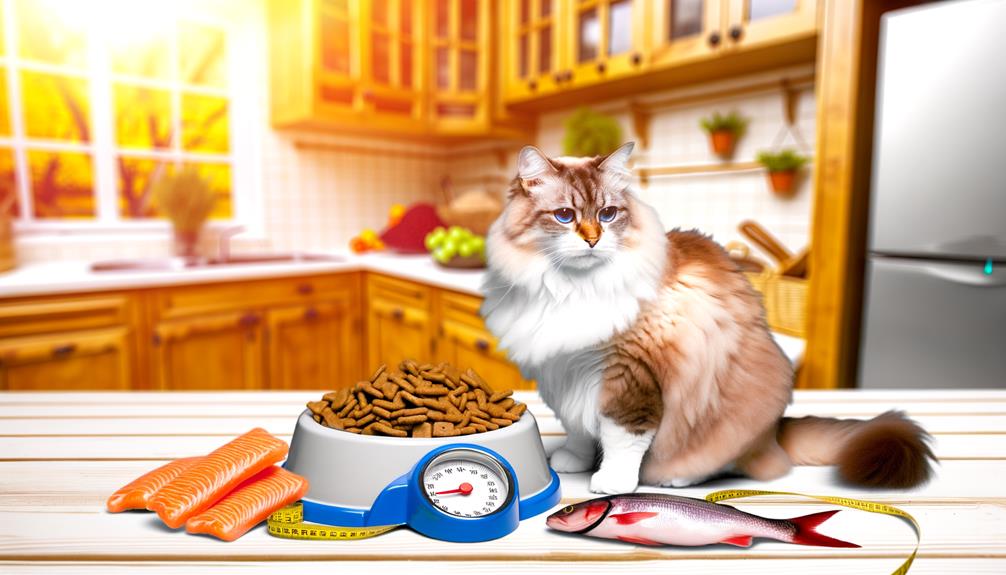When your cat's weight starts to dip, it's essential to first understand why this is happening before jumping to solutions. Consulting a veterinarian can help identify any underlying health issues that might be at play. Once you've ruled out any serious conditions, you can focus on increasing your cat's caloric intake. But how do you make sure they're actually consuming enough calories? From choosing the right high-energy foods to creating a stress-free feeding environment, there are several strategies you can employ. Want to know which ones will work best for your feline friend?
Assessing Your Cat's Weight
Evaluating your cat's weight is a critical step in ensuring their overall health and well-being. One of the most effective methods to assess your cat's weight is by using the Body Condition Score (BCS), a standard tool employed by veterinarians. The BCS ranges from 1 to 9, with an ideal score between 4 and 5 indicating a healthy weight. To perform this assessment, you can use the hand test: gently feel your cat's ribs. If they feel similar to the back of your hand, your cat is likely at a healthy weight. Conversely, if the ribs feel like your knuckles, your cat may be underweight.
Weight monitoring should be a regular part of your cat's care routine. Approximately 60% of cats in the U.S. are classified as overweight, highlighting the importance of regular weight assessments. It's crucial to involve your veterinarian when addressing weight concerns. They can help identify any underlying health issues that might be contributing to weight loss or difficulty in gaining weight. Regular veterinary check-ups are invaluable for monitoring changes in weight and body condition, ensuring that any potential health issues are detected early.
If your cat's BCS indicates they are underweight, it's important to take immediate action to address this. Your veterinarian can provide guidance on achieving an ideal weight through dietary adjustments and other interventions. Monitoring weight changes and keeping an eye on your cat's overall health will help you identify any emerging issues promptly. Ensuring your cat maintains an ideal weight is essential for their long-term health and well-being, reducing the risk of further health complications.
Identifying Weight Loss Causes
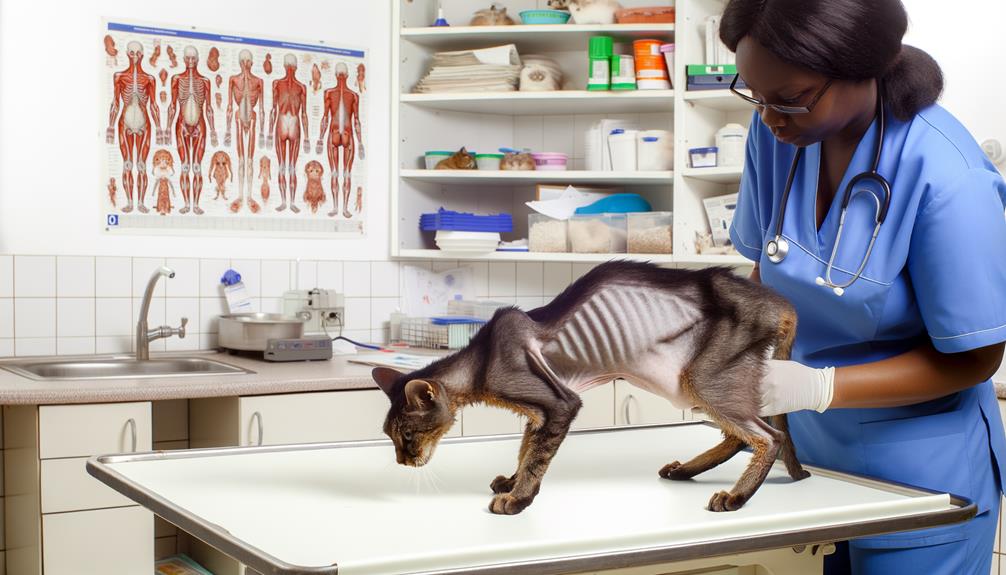
Understanding the underlying causes of weight loss in cats is imperative for devising an effective intervention strategy. When your cat is losing weight, it's important to identify the root cause, as a myriad of medical conditions could be at play. Hyperthyroidism, diabetes, and kidney disease are prominent culprits, often accompanied by symptoms such as increased thirst and appetite or lethargy. These conditions require prompt veterinary assessment to initiate appropriate treatment.
Gastrointestinal issues like inflammatory bowel disease (IBD) and food poisoning can impede nutrient absorption, leading to weight loss despite normal eating habits. It's essential to monitor your cat for signs of vomiting, diarrhea, or changes in stool consistency, as these can indicate underlying gastrointestinal issues requiring medical evaluation.
Dental problems are another significant factor. Pain from dental disease can drastically reduce your cat's willingness to eat, resulting in a loss of appetite and subsequent weight loss. Regular dental check-ups are vital to guarantee oral health is not compromising your cat's nutritional intake.
Chronic pain, often from conditions such as arthritis, can also deter your cat from eating. Cats in pain may exhibit reduced mobility and a general disinterest in food. Identifying and managing chronic pain with your veterinarian's help is crucial to avoid rapid weight loss due to decreased food intake.
Parasites, particularly roundworms, affect a substantial percentage of cats, ranging between 25% to 75%. These parasites can lead to noticeable weight loss if left untreated. Routine deworming and fecal exams are essential preventive measures.
Addressing these underlying issues through a thorough veterinary assessment will provide a foundation for any subsequent efforts to increase your cat's caloric intake and restore its healthy weight.
Increasing Caloric Intake
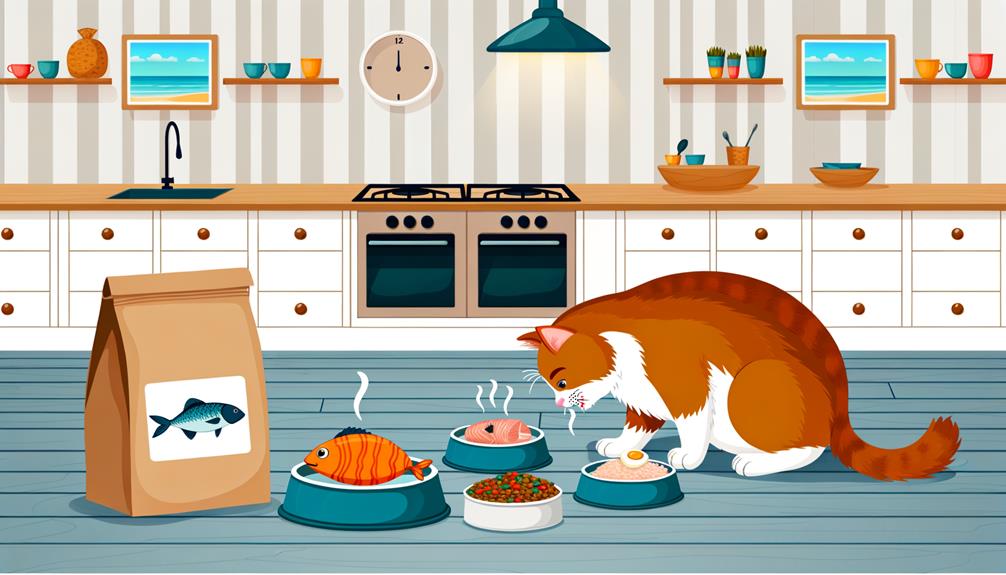
To effectively increase your cat's caloric intake, consider offering high-energy density foods like kitten food or specialized high-calorie diets. Implementing portion size management by serving frequent small meals throughout the day can stimulate grazing behavior and enhance overall consumption. Additionally, mixing wet and dry food can improve palatability and texture, making meals more enticing and promoting greater intake.
High-Calorie Food Options
When aiming to increase your cat's caloric intake, high-calorie food options become essential in facilitating healthy weight gain. High-calorie cat foods, often designed specifically for weight gain, typically contain 300-400 calories per 100 grams, providing a concentrated energy source. Opting for wet food formulas with high protein content and added fats can be particularly effective, as these are generally more palatable and encourage increased caloric intake.
Additionally, kitten food can be a beneficial choice for adult cats needing to gain weight, given its formulation to be higher in calories and essential nutrients. Some therapeutic diets, designed for weight gain, include added prebiotics and probiotics to promote digestive health while delivering sufficient caloric content.
Incorporating high-calorie treats or supplements into your cat's diet can also effectively boost their daily caloric intake. These treats and supplements often contain additional fats and proteins, providing an extra calorie boost without requiring a large increase in food volume. By carefully selecting and integrating these high-calorie food options, you can guarantee your cat receives the necessary nutrients and energy to achieve and maintain a healthy weight.
Portion Size Management
Starting with gradual adjustments to portion sizes can considerably contribute to increasing your cat's caloric intake without overwhelming their digestive system. Incrementally increasing portion sizes helps your cat adapt without causing digestive upset. High-calorie cat foods or kitten formulations are particularly effective, as they provide more energy-dense nutrients. These foods allow you to give smaller portions while still meeting your cat's caloric needs.
It's essential to monitor your cat's weight regularly. Tracking weight changes helps you assess the effectiveness of your portion size adjustments. Collaborate closely with your veterinarian to guarantee any modifications align with your cat's specific health needs.
In a multi-pet household, guarantee equal food access. Competition for food can limit individual intake, undermining your weight gain efforts. Providing separate feeding areas can help mitigate this issue.
Offering small meals multiple times a day can promote healthy grazing behavior and optimize caloric intake. This approach also aids in preventing digestive issues often associated with larger, infrequent meals.
Always consult a veterinarian before making significant changes to your cat's diet. Their expert guidance will help you tailor a weight gain plan that's both safe and effective.
Frequent Small Meals
Integrating frequent small meals into your cat's daily routine can greatly boost their caloric intake and support healthy weight gain. Offering multiple small meals aligns with your cat's natural grazing behavior, encouraging them to consume more calories throughout the day. This method is particularly beneficial as it helps to prevent overwhelming their sensitive digestive system, thereby reducing the risk of stomach upset and enhancing nutrient absorption.
To improve the palatability of your cat's diet, serving frequent meals can make the food more appealing, especially for those with reduced appetites. In multi-pet households, making sure that all cats have equal access to food during mealtimes can mitigate competition and stress, contributing to a more consistent feeding pattern.
Positioning food bowls in calm, low-stress environments is essential. A tranquil feeding environment encourages regular eating, which is important for increasing caloric intake and achieving weight gain.
| Feeding Strategy | Benefits |
|---|---|
| Frequent meals | Increases caloric intake |
| Small portions | Prevents digestive system overload |
| Equal access in multi-pet | Reduces stress, makes sure consistent feeding |
| Calm feeding environment | Encourages more frequent eating |
Enhancing Food Appeal
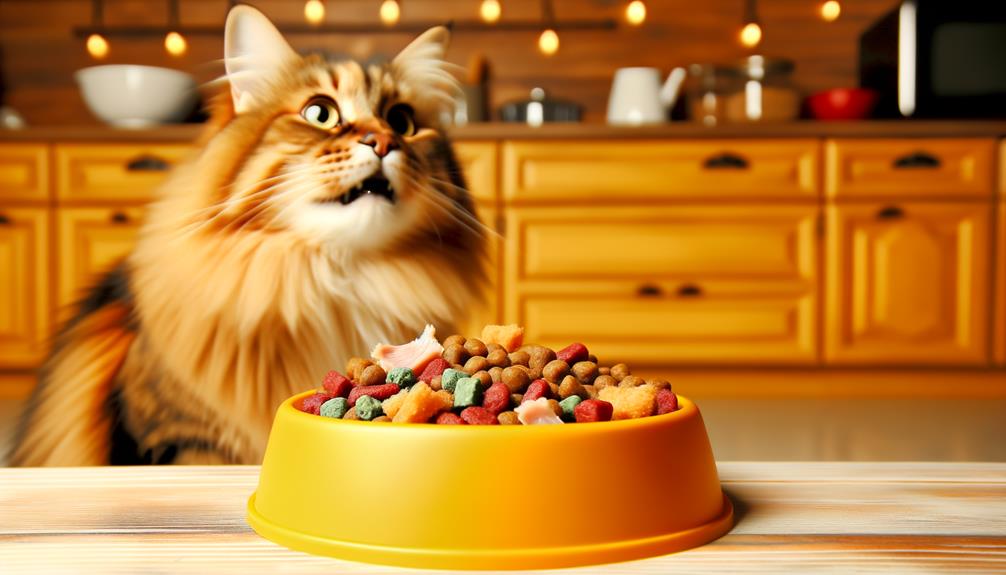
To enhance food appeal for your cat, it's vital to experiment with various flavors and textures of cat food, since cats often have particular preferences that can greatly influence their eating habits. By understanding and leveraging these preferences, you can effectively stimulate their appetite and encourage consumption.
- Different Flavors and Textures: Cats can be selective eaters, so offering a variety of flavors and textures in their diet can be advantageous. Wet cat food is often more appealing due to its strong aroma and moisture content. Slightly heating wet food can further enhance its scent, making it more enticing.
- Enticing Food Items: Incorporating small amounts of high-value treats can make meals more appealing. Foods like rotisserie chicken or the liquid from canned tuna can be mixed with your cat's regular diet to tempt them to eat. These additions should be used sparingly to guarantee a balanced diet.
- High-Calorie Foods and Therapeutic Diets: For cats needing to gain weight, high-calorie foods or therapeutic diets specifically designed for weight gain can be introduced. These diets are formulated to meet the increased nutritional needs without requiring larger portion sizes, making it easier for your cat to consume the necessary calories.
- Mealtimes Simple: Keeping mealtimes stress-free is imperative. Avoid excessive fuss and provide a calm feeding environment. This simplicity can help reduce anxiety and make feeding times more enjoyable, thereby encouraging regular consumption.
Feeding Strategies
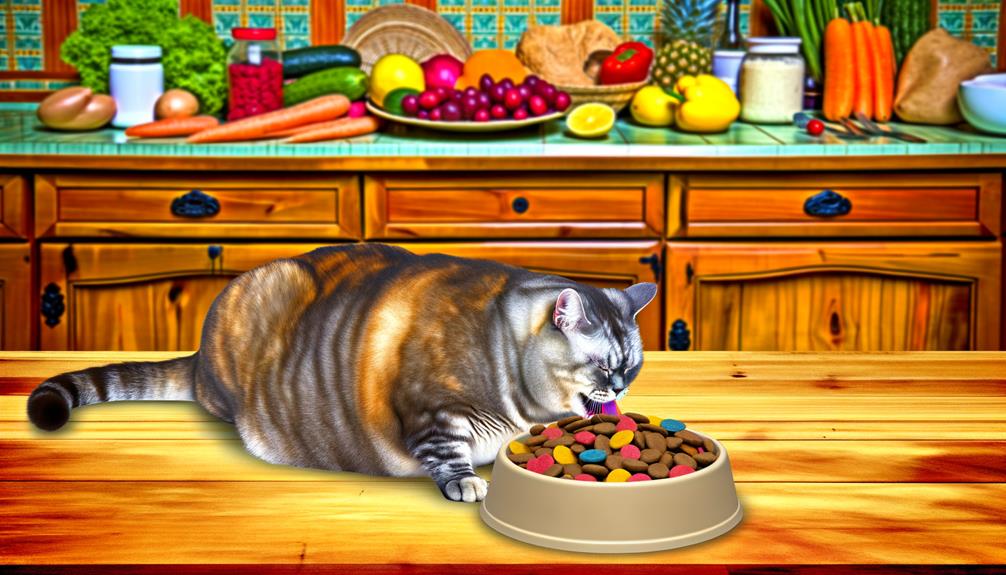
Feeding strategies are essential in helping underweight cats gain weight effectively. Implementing multiple small meals throughout the day can encourage grazing behavior, which is beneficial for increasing your cat's caloric intake. By allowing your cat to eat more frequently, you provide continuous opportunities to consume the necessary calories.
Positioning food bowls in a calm environment is vital. A stress-free setting can promote a more relaxed eating atmosphere, making your cat more likely to eat. Additionally, ensuring that all cats have equal access to food in a non-threatening environment helps prevent competition and fosters regular eating habits.
Enhancing the palatability and energy density of meals can be achieved by mixing dry and canned food. This combination not only makes meals more appealing but also boosts the overall caloric content. Gently warming wet food can further stimulate your cat's appetite by intensifying its aroma, making it more enticing for cats reluctant to eat.
Creating a consistent routine for feeding and providing access to food throughout the day can greatly impact your cat's weight gain. By doing so, you support natural grazing behavior and help maintain a steady intake of calories.
Veterinary Consultation
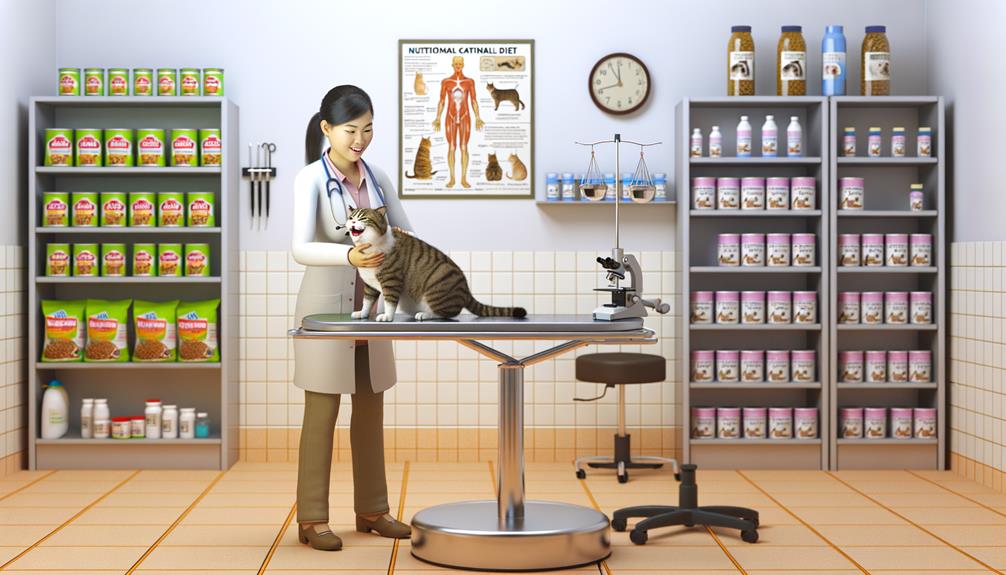
Consulting a veterinarian is vital when addressing a cat's weight gain issues. A professional veterinary consultation guarantees that any underlying health conditions are identified and addressed, paving the way for a tailored weight gain strategy. Here's how a veterinarian can help:
- Initial Assessment: The veterinarian will conduct a thorough examination to identify any serious health issues such as hyperthyroidism, diabetes, or kidney disease. These conditions can cause significant weight loss and need to be ruled out before any dietary changes are implemented.
- Dietary Recommendations: Based on the initial assessment, the veterinarian may suggest specific high-calorie diets or therapeutic foods designed to support weight gain. These diets not only help increase caloric intake but also guarantee balanced nutrition, which is critical for overall health.
- Appetite-Stimulating Medications: If dietary adjustments alone aren't effective, the vet might prescribe appetite-stimulating medications. These can help increase your cat's appetite, facilitating more consistent weight gain. Professional recommendations are vital here to guarantee the medications are appropriate and safe for your cat.
- Regular Monitoring: Regular veterinary check-ups are important to monitor your cat's weight and make any needed adjustments to the weight gain plan. This continuous oversight helps guarantee that the dietary changes and any medications are effective and that your cat is gaining weight in a healthy manner.
Monitoring Progress
Monitoring your cat's progress is essential to guarantee that weight gain strategies are effective and aligned with veterinary recommendations. Regularly weighing your cat at home or during veterinary visits is fundamental. This helps you track weight gain and confirms it matches your veterinarian's plan. You can use a digital scale for accuracy, and aim to weigh your cat weekly for consistent data.
Utilize the Body Condition Score (BCS) system to objectively assess changes in body fat and muscle mass. The ideal BCS for most cats is between 4-5 out of 9. This system provides a more nuanced understanding than weight alone, helping you and your vet make informed decisions about diet and health.
Keep a detailed feeding log. Note the amounts and types of food your cat consumes daily. Tracking your cat's appetite is essential; any changes can indicate health issues or the effectiveness of the dietary adjustments.
| Aspect | Frequency | Purpose |
|---|---|---|
| Weighing | Weekly | Track weight gain |
| Body Condition Score | Monthly | Assess fat and muscle changes |
| Feeding Log | Daily | Monitor food intake and appetite |
Additionally, schedule regular veterinary follow-ups. These visits allow for professional evaluation of your cat's overall health and necessary adjustments to the diet plan. They also help identify any underlying health issues that might be impeding weight gain.
Lastly, observe your cat's overall condition, including energy levels, coat quality, and behavior. Improvements in these areas can be indicators of successful weight gain and better health. By systematically monitoring progress, you can confirm that your cat's weight gain is both effective and healthy.
